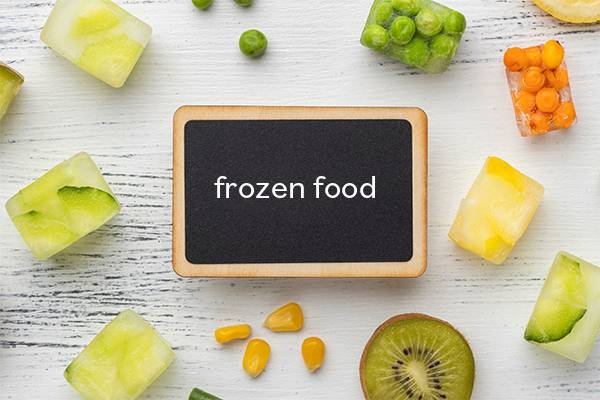
The COVID-19 pandemic has triggered an explosive growth in demand for frozen foods. According to a household survey conducted by the Ministry of Internal Affairs and Communications, the average annual expenditure on frozen foods per household in 2021 was \ 7,751. This is an increase of about 34% compared to 2019, before the pandemic began. In this survey, we have explored how frozen foods are being embraced, and by whom.
Looking at the purchase frequency of frozen foods first, we see that about 40% of respondents said they had purchased frozen foods on more than 1 day a week within the last month (Figure 1).
Next, in terms of frozen foods purchased recently, well-established items such as gyoza, noodles, and rice came top with over 30% (Figure 3). In addition to main lunch box and dinner items such as deep fried chicken and shumai, frozen vegetables also saw increased popularity.
Looking at the change in purchase frequency of each item compared to before the COVID-19 pandemic, all 23 of them showed a two-digit increase (Figure 4). This suggests that the pandemic has seen frozen foods become widely embraced. The items with particularly high increases were frozen fruits, frozen vegetables, and noodles, with about 30% of respondents saying they were now purchasing them more often. It is therefore plausible that more and more people are using frozen ingredients in their cooking.
Looking at the breakdown by gender and life stage for people who bought frozen foods as often as 2 or more days a week, as many as 20% of them were child-raising women and men (Figure 5). This suggests that frozen foods are being embraced not only by women (who are often the main cooks), but by men as well.
Looking next at the rate of purchasing multiple items by attribute, in the breakdown by gender and life stage, doing so was extremely prevalent among child-raising women, accounting for 50% (Figure 6). Factors behind this could be the heightened food consciousness and hectic lifestyle that characterize the parenting years. Also, in the breakdown by annual household income, about 40% of households earned above \ 6 million, and in terms of area resided in, Tokyo accounted for more than 40% of respondents. This reveals a need among Tokyo residents both to save time and use it effectively.
In terms of where people bought their frozen foods, small supermarkets accounted for an extremely high share of about 70%, followed by large supermarkets at about 50% (Figure 8). Besides these, drugstores accounted for about 20% and even convenience stores had a share of over 10%. This shows that more and more types of business are starting to handle frozen foods or to do so more, and people are buying them from a wider range of places.
In terms of the meals where people ate frozen foods in the last month, dinner was the most common at 50%, followed by lunch at over 40% (Figure 9). Looking at the change in frequency compared to before the COVID-19 pandemic, we found that all meals saw two-digit increases, revealing that people are using frozen foods more and more widely (Figure 10). In addition to the lifestyle changes due to the pandemic, a steady stream of new frozen food products like fruit and bread are being sold, showing that use for breakfast and snacks is expanding.
Next, looking at the reasons for purchasing frozen foods, "quicker cooking," "storability," "tastiness," and "enjoying flavors I can't make myself" came top overall (Figure 11). Being able to enjoy these various advantages is also likely to be contributing to the growing demand for frozen foods.
In addition, in the breakdown by gender and life stage, child-raising women had the highest rate of purchasing frozen foods, and their top reasons were "quicker cooking" and "convenience," followed by "enjoying flavors I can't make myself." "Tastiness" came top among single men.
In the breakdown by cooking frequency, "storability" was the main reason for purchasing them among people who cooked with them almost every day, and "convenience" was the main reason for people who did so 4 to 5 days a week.
Looking at food consciousness by attribute, among child-raising women, more people said they chose trending foods and ones with health and beauty benefits than those who said they felt cooking was a burden (Figure 12).
Next, we see that the rate of purchasing multiple frozen foods by food consciousness was higher among people whose consciousness to food matched the above three than it was among people whose attitudes did not (Figure 13). Similarly, the rate of increase in purchase frequency compared to before COVID-19 was higher among people whose consciousness to food matched the given ones (Figure 14). This reveals that being highly food-conscious like this is a factor behind why child-raising women have a high purchase frequency and rate.
Plausible reasons for the rapid growth enjoyed by frozen foods in the COVID-19 pandemic are that their storability and convenience lighten the burden of having to cook more due to eating at home more often. The market should be expected to become increasingly lively as penetration of the wide-ranging benefits of frozen foods spreads, and suppliers expand their product lineups. In addition, health consciousness, food enjoyment, the burden of cooking, and similar food consciousness that are motivating people to purchase frozen foods are likely to persist as the COVID-19 pandemic continues, so demand is likely to continue to grow.
Translating articles
- 6.9 Trillion Yen Market Created By Women― Will Afternoon Tea save the luxury hotels in the Tokyo Metropolitan Area
- The Penetration of Premium Beer, and a Polarization of the Growing Beer Market
おすすめ新着記事

消費者調査データ 炭酸飲料(2024年7月版) 首位「コカ・コーラ」、迫る「三ツ矢サイダー」、高い再購入意向の無糖炭酸水
2023年は3年連続プラスとなった炭酸飲料。調査結果を見ると、今回も「コカ・コーラ」が複数項目で首位を獲得したが、2位の「三ツ矢サイダー」の猛追が光る。再購入意向は、無糖炭酸が上位に食い込んだ。

消費者調査データ スポーツドリンク・熱中症対策飲料(2024年7月版) 首位「ポカリスエット」、追い上げる「アクエリアス」
人流の回復や猛暑などを背景に伸びる熱中症対策飲料・スポーツドリンクの調査結果をみると、ロングセラー「ポカリスエット」が再購入意向を除く5項目で首位を獲得した。5ポイント程度の差で追うのは「アクエリアス」。さらに10ポイント前後のビハインドで「GREEN DA・KA・RA」が続く。

成長市場を探せ 初の6,000億円超え、猛暑に伸びるアイスクリーム
2023年度、空前の暑さを追い風に、アイスクリーム市場は初の6,000億円超えを達成、4年連続で過去最高を更新した。2023年の夏日日数は140日、実に1年の4割近くの日が「アイスクリームを食べたくなる」気温である25度を超えたことになる。




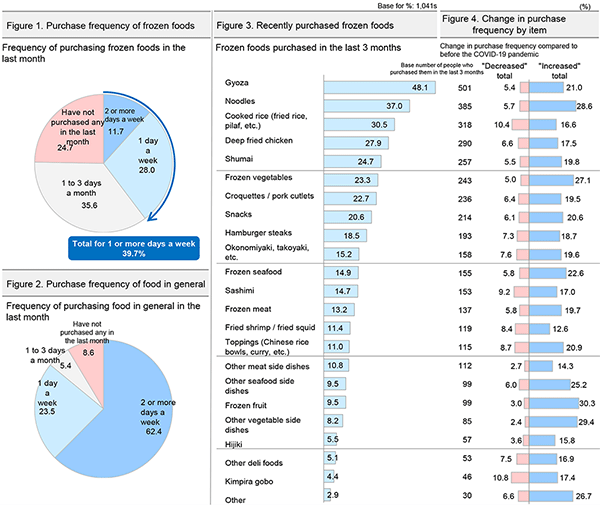
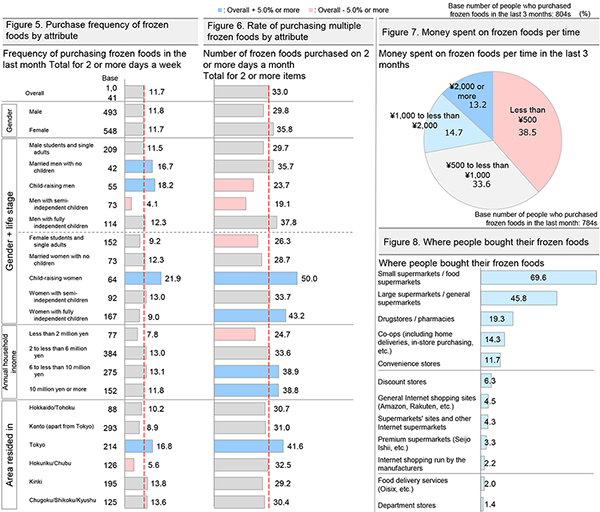
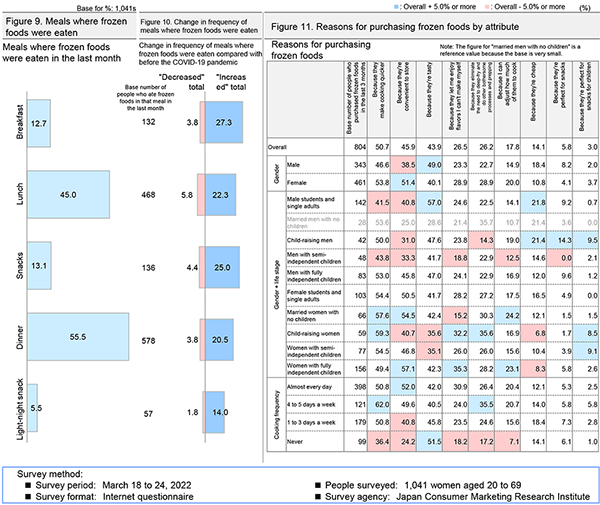
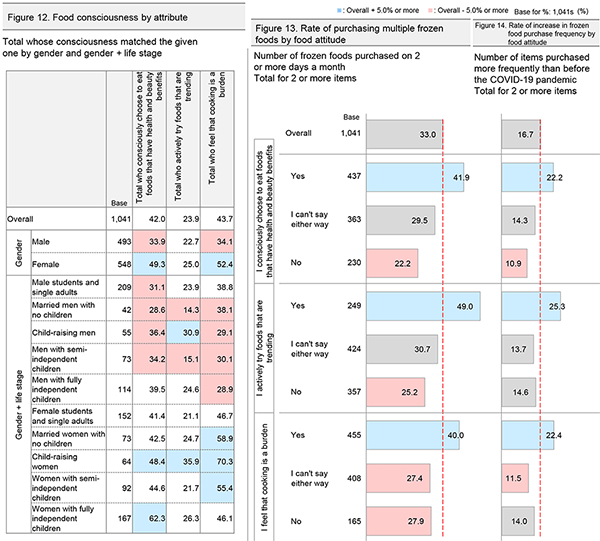

![戦略家のための知的羅針盤[エム・ネクスト]product by 松田 久一](/img/mnext-sub-title.png)



